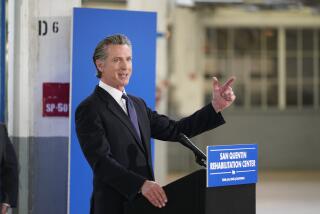Schools Win, Lose in Governor’s Proposal
Gov. Arnold Schwarzenegger and education leaders outlined a compromise budget deal Thursday that would provide K-12 schools and community colleges a 2% cost-of-living increase and additional money for enrollment growth but would delay about $2 billion in extra money owed to them.Schwarzenegger said the proposal, which is contained in the budget that he will unveil today, would increase school spending by an average of $200 per pupil. The statewide average per student now is about $6,800.
But schools would have to wait for another $2 billion of the $4 billion owed to them under Proposition 98, the constitutional amendment that sets levels of school funding, until state revenues pick up next year or later. The state would use that money to help offset a projected $14-billion budget deficit.
Schools and community colleges statewide are receiving about $30 billion in general revenue funds this year, but the total proposed for next year will be released today, along with other details.
The plan outlined Thursday drew sighs of relief from some school district administrators who had feared far deeper reductions next year. But others, saying that schools need the entire $4 billion to pay their bills, predicted that the budget plan would not resolve anticipated deficits in the year to come.
“It looks like we will have a slightly smaller hole to dig ourselves out of,” said Richard Van Der Laan, a spokesman for the Long Beach Unified School District, which faced a $20-million gap in its $456-million operating budget next year.
Van Der Laan said the budget proposal would provide the district with about $9 million more than anticipated and that $6 million of that would probably go for teachers’ wage increases. So, the district still would have to cut services to make up the difference to pay for rising costs for workers’ compensation insurance, health benefits and utility bills, among other things.
Schwarzenegger called the plan, which was brokered in private talks with education leaders last month, the best possible outcome for California’s public schools -- even as some Democratic legislators accused the governor of reneging on campaign promises to fully protect education spending next year. “Everyone understands the crisis we face and that is why it was important that we came to an agreement to deal with the budget crisis and protect per-pupil funding,” Schwarzenegger told a news conference Thursday at a Sacramento middle school. He was flanked by representatives of the California Teachers Assn., the California School Boards Assn. and the Assn. of California School Administrators, the groups involved in private talks last month that produced the budget deal.
Next year’s budget is expected to exact less pain than did this year’s spending plan, which forced many districts to lay off teachers, dip into reserves and abandon smaller class sizes in kindergarten through third grade.
The spending proposal, like the entire budget, needs the approval of the Legislature in the coming months. Gwen E. Gross, superintendent of the Manhattan Beach Unified School District, had anticipated having to cut about 10% of the district’s budget next year.
She said that the governor’s proposal would not help a lot, but that she preferred to take a longer view, based on her sense that the governor is committed to education.
“I strongly believe that things will get better in the future because of this,” she said.
Supt. Arturo Delgado of the San Bernardino City Unified School District questioned how long teachers could maintain quality programs if state funding did not improve soon.
Delgado said his budget writers had assumed that the state would provide a 2% cost-of-living increase and would pay for enrollment growth.
So the governor’s budget proposal will not markedly change its projected budget picture for the growing district, which enrolls about 58,000 students in kindergarten through 12th grade.
Conservative spending and cooperation of employee groups allowed San Bernardino city schools to avoid dipping into reserves or increasing class sizes to stay in the black, even with the steep cuts in state funding midway through the last school year, Delgado said.
“It’s never good news when you take $2 billion from education,” he said. “We are really playing with the quality of our children’s education” by repeatedly withholding promised funding improvements.
The 740,000-student Los Angeles Unified School District’s fiscal officials were not counting on a cost-of-living adjustment from Sacramento when they began work on a 2004-2005 budget. They had expected to be in the red by $536 million, about 10% of the district’s $6-billion operating budget.
A cost-of-living adjustment of 2% would net the district about $70 million -- a help, but a gap of about $460 million would remain.
*
Helfand reported from Sacramento and Merl from Los Angeles.
More to Read
Get the L.A. Times Politics newsletter
Deeply reported insights into legislation, politics and policy from Sacramento, Washington and beyond. In your inbox three times per week.
You may occasionally receive promotional content from the Los Angeles Times.










